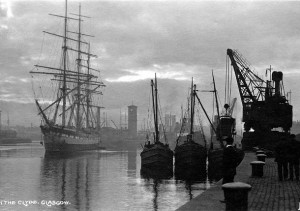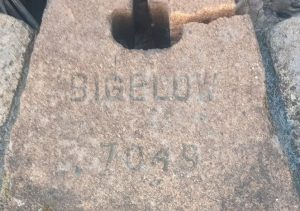… Over the centuries many of Scotland’s sons and daughters have emigrated overseas, and trade has followed, particularly the export of whisky. The export of refractories is less well known and would be an interesting study for a historian. Prior to the First World War, Glenboig and Steins were sending firebrick to Russia in quantity, sufficient in Stein’s case to warrant the issue of a Russian catalogue. In Canada apart from the metallurgical industries, firebricks were imported for house building as common bricks would not stand up to the severe frosts. Stein firebrick went to build Chateau Frontenac bin Montreal. Australia was a large market up to the Second World War with blast furnace linings of 1,000 tons a time. Many countries did not have a sufficiently large industrial market to support a refractory industry and had to import. Firebrick from the Scottish midlands were made within 5 miles of east coast ports where they could be shipped to Europe and within fifteen miles of the Clyde which had many shipping lines with regular services covering the world. Some markets, such as Australia, diminished as their industry grew and a local refractory industry was established. However other younger countries were starting up.
Initially, enquiries arrived by letter from individual traders overseas, and if the price was attractive they imported the refractories on their own account and resold at their own prices. As competition developed they became agents and received discounts, usually around 5-10%, which protected their interests from customers who might seek to import direct.
Such agents had the technical knowledge to advise customers with confidence, so in 1927 Robert Malcolm was appointed to visit home and export customers. Within a year he was visiting Estonia, Latvia, and Finland, making friends and sign language the choice of refractories.
The Second World War interrupted the exports to Europe, and afterwards, the networks of agents had to be rebuilt. Some such as Aage Andreasen of Denmark survived after much suffering with a spell in the hands of the Gestapo. He had offices in Norway and Sweden, and in the latter country with the help of Gunnar Dahlen and Ove Wensing, many orders were received including blast furnace linings for a steelworks north of the Arctic Circle. It was in the Holger Andreasen office that Colins son, John Stein, served a three-year apprenticeship, learning four languages fluently and a smattering of others. this was to serve John well when he became the Export Director of G.R.-Stein.
Alex Smit and Kes Clason were agents in Holland, where the Royal Dutch Steelworks were perhaps the most advanced steel-makers in Europe. Nol Tjassen-Keiser, another Dutchman, was recruited on to the Stein staff and his experience and languages were used to advise customers in many countries.
Belgium and Luxemburg were excellent markets served by Jean-Charles Beer, his brother-in-law Jaques Vasseur, and Pierre de Meyere, from the offices of Picart & Beer in Brussels. They worked hard and enthusiastically and had a good knowledge of the iron and steel problems.
France was a small market as they had a good refractory industry of their own. Germany with a large steel industry, and at one time perhaps the foremost refractory industry in Europe, was a difficult but rewarding market, served by Otto Liska and his firm. Max Viezzoli in Italy had his own drawing office and could design furnace linings and specify Stein’s brick. Switzerland is a small country but at times transmitted large orders from other countries. Surprisingly, Turkey produced large orders at times and Yves Kirec was perhaps the only agent with enough pull to summon the government clerk to come to his office with the necessary import permits.
The author made a trip to Spain shortly after the war, to meet the new agent, Eduardo de Goyoaga, and point out where refractories were sold. When flying from Bilbao to Madrid in a converted Bristol freighter, Eduardo insisted on the two tail seats. Once airborne he announced that the last time he had flown on this flight they had crashed! Seeing the look he got, he explained that those forward of the wings might be killed, for the plane would break its back at the wings, but those in the tail would be safe. The plane had crashed into the Guadarrama mountains just north of Madrid, and Eduardo crawled out with two broken legs to lie on the snow. The radio girl went off duty about the time the plane was due to land, and the replacement thought the plane had landed so no one was worried. General Franco was giving a dinner party that evening and one of his guests flying from Bilbao did not appear. Only then nit was realised that the plane was missing, and search parties found it the next morning. Eduardo was tough and survived to become the director of one of the biggest hotel groups in Spain, and his partner Ramon de Vecino ran the refractory agency.
Mr Sitarama of the Sastri Trading Company of Calcutta worked hard for the very restricted foreign currency allowed for imports into India. Ed Gamble in South Africa competed against good local bricks, and his brother helped Ronald Stein to investigate special raw materials which were imported into Scotland.
Of the South American countries, only Argentina was a good market and that only every two or three years when the foreign currency was available. Some substantial orders were obtained at these times, as Mr Mellor, a Yorkshireman, and an adopted Argentinian, made sure he got the most of the allocation.
Most of these markets were visited by directors, technical staff, and some home salesmen so that they could speak at first hand of their furnace experience to the foreign customer. It broadened their own outlook, and they could speak with more authority to their home customers.
Foreign agents normally have other agencies to compete for their time, and can easily get out of touch with refractory developments. The biggest boost to their morale and interest in refractories was the Export Sales Conference held every second year at Gleneagles, to which their wives were invited. Over a long weekend, visits to the works were arranged, and in technical sessions, new developments and problems in markets were discussed. Sometimes another agent had had a similar problem had could suggest a solution.
The estimating department and order department personnel were invited to meet the people to whom they wrote and spoke to on the telephone round the year. This personal contact was invaluable in welding the selling effort together …
Source Stein of Bonnybridge by Kenneth Sanderson
Below – John G Stein and Co catalogue.












